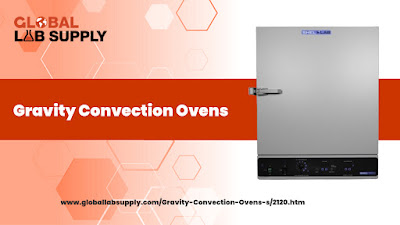Gravity convection ovens are widely used in laboratory and industrial settings for various applications, including drying, sterilizing, and heat treatment processes. These ovens rely on the principle of natural convection to provide consistent and uniform heat distribution. Global Lab Supply understands the importance of understanding the science behind gravity convection ovens. In this article, we will explore how gravity convection ovens work, the underlying scientific principles, and why they are effective in achieving precise and reliable heating.
Natural Convection:
Gravity convection ovens operate based on the principle of natural convection, which is the process of heat transfer through the movement of air. When air is heated, it becomes less dense and rises, creating an upward flow. As the heated air rises, cooler air replaces it, leading to a continuous circulation of air within the oven chamber. This circulation allows for the transfer of heat from the heating elements to the contents of the oven.
Heat Source:
Gravity convection ovens utilize electric heating elements as the heat source. These elements are typically located at the bottom or sides of the oven chamber. When the heating elements are activated, they generate heat, which then rises and creates the convection currents within the oven.
Uniform Heat Distribution:
One of the key advantages of gravity convection ovens is their ability to provide uniform heat distribution. As the heated air rises and circulates, it comes into contact with the contents of the oven, transferring heat to them. This convection process ensures that the temperature is consistent throughout the oven chamber, resulting in even and precise heating of the materials being processed.
Temperature Control:
Gravity convection ovens are equipped with temperature control systems that allow users to set and maintain specific temperature levels. These systems monitor the temperature within the oven chamber and adjust the heating elements accordingly to maintain the desired temperature. This precise temperature control ensures accuracy and repeatability in heating applications.
Heat Transfer Efficiency:
Gravity convection ovens are known for their high heat transfer efficiency. The natural convection process allows for efficient heat transfer from the heating elements to the materials being processed. This efficiency reduces processing times and energy consumption, making gravity convection ovens a cost-effective choice for many applications.
FAQs (Frequently Asked Questions):
Q1. What types of materials can be processed in a gravity convection oven?
Gravity convection ovens can be used for a wide range of materials, including glassware, instruments, samples, and other heat-resistant materials. They are commonly used in laboratories for drying glassware, sterilizing equipment, and conducting heat treatments on various samples.
Q2. Can gravity convection ovens be used for heat-sensitive materials?
Yes, gravity convection ovens are suitable for heat-sensitive materials. The gentle and uniform heat distribution provided by these ovens helps prevent overheating and ensures the safe processing of delicate or sensitive samples.
Q3. Are gravity convection ovens suitable for precise temperature-sensitive applications?
Gravity convection ovens can achieve precise temperature control, but they may have slight temperature variations within the oven chamber due to the nature of natural convection. If highly precise temperature control is required, other types of ovens, such as forced convection or vacuum ovens, may be more suitable.
Q4. How important is proper ventilation for gravity convection ovens?
Proper ventilation is crucial for the performance of gravity convection ovens. Adequate airflow within the oven chamber ensures efficient heat transfer and prevents the buildup of moisture or contaminants. It is important to follow the manufacturer's guidelines regarding ventilation requirements and ensure that the oven is placed in a well-ventilated area.
Q5. Can gravity convection ovens be used for applications that require specific humidity levels?
Gravity convection ovens primarily focus on temperature control rather than humidity control. If humidity control is necessary for your application, additional equipment such as humidity generators or chambers may be required.
Conclusion:
Gravity convection ovens operate on the principle of natural convection, providing uniform and reliable heat distribution. With their precise temperature control and high heat transfer efficiency, these ovens are essential tools in laboratories and industrial settings. Understanding the science behind gravity convection ovens helps users appreciate their functionality and effectiveness in achieving accurate and consistent heating. Global Lab Supply offers a range of gravity convection ovens designed to meet various application requirements. By harnessing the principles of natural convection, these ovens provide an efficient and cost-effective solution for drying, sterilizing, and heat treatment processes.

No comments:
Post a Comment